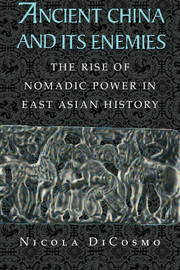Book contents
2 - Bronze, Iron, and Gold: The Evolution of Nomadic Cultures on the Northern Frontier of China
Published online by Cambridge University Press: 25 August 2009
Summary
Introduction: The Northern Complex
Scholars have long recognized that a cultural frontier, understood as an area of contacts among carriers of different material cultures, existed to the north of China as early as the Shang dynasty. The origin of this cultural complex, its connection with China and areas in Central and northern Asia, and the characteristics of the separate cultural enclaves recognizable within it have been objects of much debate. Yet two critical questions remain unanswered: When do we begin to see a clearly delineated frontier between China and the north? More importantly, how do we define the northern frontier?
China's frontier has been often understood as an ideal line dividing two ecological zones: the steppes and deserts of the north and the farmland of the south. Although this line may have shifted north or south in response to climatic variations over time, from the viewpoint of human agency this interpretation of the frontier remains fundamentally static and tells us little about cultural exchange and political interaction.
Until the third century b.c. – when a clearly demarcated political boundary between the north and China emerged with the formation of the Hsiung-nu empire (209 b.c.) – the northern frontier of China remained extremely fluid. However, at least three interconnected but independent processes played roles in defining the northern frontier: one ecological and economic, another cultural, and the last political.
- Type
- Chapter
- Information
- Ancient China and its EnemiesThe Rise of Nomadic Power in East Asian History, pp. 44 - 90Publisher: Cambridge University PressPrint publication year: 2002
- 1
- Cited by



